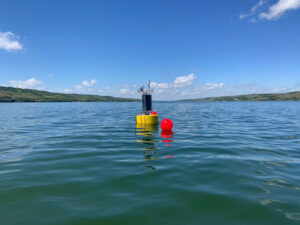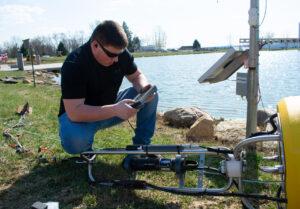Thermo Orion Star A321 Portable pH Meter
Features
- Calibration editing ensures accurate pH, mV, RmV and temperature readings
- AUTO-READ function alerts user and locks stable readings on backlit LCD screen
- USB and RS-232 ports allow easy data transfer of up to 5000 time-stamped data points
- Free ground shipping
- Expedited repair and warranty service
- Lifetime technical support
- More
Overview
The waterproof, battery-operated Thermo Orion Star A321 portable pH meter stands up to the most demanding field applications to deliver the most advanced performance of any portable meter. Four AA batteries, included with purchase of the A321, provide over 800 hours of continuous operation, so the instrument is ready when it's needed, where it's needed. The meter displays reliable pH, mV, RmV and temperature readings on a large, backlit LCD screen and automatically locks in stable readings.
Mechanics
Thermo Orion Star A320 series portable meters provide the largest storage capacity available for time-stamped data points, which can be conveniently uploaded to a PC through the meter's USB and RS-232 ports. Automatic or 1 to 5 point manual calibration makes instrument setup simple, while icons provide quick updates on battery life, electrode status and calibration information. The simple button layout and on-screen messages also assist with calibration and explain setup menu choices.
Benefits
- AUTO-READ function alerts user and locks on-screen readings when stable
- Up to 5 point pH calibration with calibration editing
- Automatic recognition of USA/NIST and DIN buffers
- Easy to recall calibration slope data for procedure checks
- Non-volatile memory holds up to 5000 data points
- USB and RS-232 ports to upload data and update included data analysis software
- Universal power supply or battery power option
- Universal power adapter (sold separately) runs meter on AC power
- Multilanguage interface supports English, Spanish, French, Italian, German and Chinese
- IP67-rated waterproof housing (can be immersed up to one hour with no water incursion)
- 3 year meter warranty
- pH
- Range: -2.00 to 20.00
- Resolution: 0.1, 0.01, 0.001
- Relative Accuracy: +/-0.002
- Calibration Points: Up to 5
- Calibration Editing: Yes
- mV/RmV
- Range: +/-2000.0 mV
- Resolution: 0.1 mV
- Relative Accuracy: +/-0.2mV or 0.05%, whichever is greater
- EH ORP Mode: Yes
- Temperature
- Range: -5 to 105 C
- Resolution: 0.1
- Relative Accuracy: +/-0.1 C
- Offset Calibration: 1 point
- Datalogging
- Number of Points: 5000 with time and date stamp
- Log Function: Manual, ready (AUTO-READ), timed
- Log Edit: Delete individual points, group of points or all
- General
- Display: Backlit LCD
- Inputs: pH Electrode - BNC, ATC Probe - 8-pin mini-DIN
- Outputs: RS-232, USB
- Power Adapter: Universal AC, 100-240 VAC
- Battery Power: 4 AAs, 800 hrs life
- Environmental Requirements: 5 to 45 C and 5 to 85% relative humidity, non-condensing
- Regulatory and Safety: CE, TUV 3-1, FCC Class A
- IP Rating: IP67, waterproof
- Warranty: 36 months (from date of purchase)
In The News
Combating Water Insecurity in Saskatchewan with Real-Time Data
The prairies of Saskatchewan can be described as one of the least water-secure parts of Canada, making water quality monitoring essential for informed resource management in a region already facing water insecurity. While natural physical properties worsen some of the poor water quality conditions in the region, others are connected to land use. Having grown up spending summers on the shores of Lake Huron, Helen Baulch, an associate professor at the School of Environment and Sustainability at the University of Saskatchewan , has always been dedicated to the protection of water resources. Looking back fondly at her childhood playing along the shore, Baulch also recalls the invasion of quagga mussels during her teenage years and watching the lake change as a result.
Read MoreSeametrics Turbo Turbidity Logger: Boost your Turbidity Monitoring
The Seametrics Turbo Turbidity Logger is a self-cleaning turbidity sensor capable of internally logging over 260,000 data records. The sensor enables researchers, compliance officers, and contractors to monitor turbidity in various applications, from construction and dredging sites to wastewater effluent. Due to its narrow width, this device can be deployed in a range of areas, from small well spaces to rivers and streams. The stainless steel housing and built-in wiper allow the sensor to withstand long-term deployments and reduce the need for maintenance trips. The logger accurately records temperature and turbidity up to a depth of 50 meters.
Read MoreCollecting Data at the Top of the World: How Scientists Retrieve Glacial Ice Cores
A helicopter touches down in the small town of Sicuani, Peru, at an elevation of 11,644 feet. Earlier that day, a boxcar brought fuel, drills, food, and other equipment for a glacial expedition. The year is 1979, and glaciologist Lonnie Thompson is preparing to lead a team to the Quelccaya ice cap in hopes of becoming the first scientists to drill an ice core sample from this glacier. The only problem? The glacier is located at 19,000 feet in one of the most remote areas of the world. The helicopter takes off from the town, but the thin atmosphere at that elevation does not allow it to safely touch down on the ice– due to the aircraft’s weight, and it becomes unstable when the air is less dense.
Read More
























